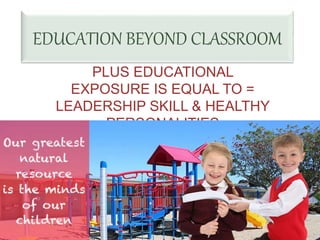
EDUCATION BEYOND CLASSROOM2
- 1. EDUCATION BEYOND CLASSROOM PLUS EDUCATIONAL EXPOSURE IS EQUAL TO = LEADERSHIP SKILL & HEALTHY PERSONALITIES
- 2. SPECIAL EDUCATION TO EXCEPTIONAL CHILDREN • Educating exceptional children is an exciting, challenging , and rapidly changing career. • But before we describe facts about handicapped and gifted children, specific educational programs and instructional techniques must be apply and some of the joys and accomplishments that can be obtained when professionals and parents works together, we need to presents several concepts basic to an understanding of exceptional children and special education.
- 3. WHO ARE THE EXCEPTIONAL CHILDREN • Before we can list the general characteristics of exceptional children, we must define and differentiate three terms: • EXCEPTIONAL • HANDICAP • DISABILITY • Exceptional is an inclusive term that refers to any child whose performance deviates from the norm, to such an extent that special education programming is indicated.
- 4. Handicap & Disability • Handicap ;refers to the problems and difficulties a person encounters because a physical disability or behavioral characteristic mark him or her as different from other individuals. Handicap is a more restrictive term than exceptional and does not include the gifted. • Disability; is a physical problem that limits a person’s ability to perform certain tasks that most other people can perform. It is basically the same as an impairment. A disabled person is not handicapped. However, unless that physical problem leads to educational, social, vocational, or other difficulties.
- 5. EXCEPTIONAL CHILDREN • Exceptional children can be loosely classified as falling into one or more of the following: 1) Mental retardation 2) Learning disability 3) Behavior disorders (emotionally disturbed) 4) Communication (speech and language) disorder 5) Hearing impairments 6) Visual impairments 7) Physical and other health impairments 8) Severe handicaps 9) Gifted and talented. How many exceptional Children? Lets take a quick look at some of the major findings of a survey of special education in the United State conducted at the request of congress (U.S. Controller General, 1981) Nearly 4.2 million children received special education during the 1980-81 school year.
- 6. PLAY TO LEARN & LEARN TO PLAY? Through play children learn about themselves, their environment, people and to get along with others. They enhance their creativity and develop leadership skill and healthy personalities. Play develops skills children need to learn to read and write. Play in early childhood is the foundation for success in school.
- 7. PLAY TO LEARN TAKES ONE STEP UP Positive play experiences develop positive emotional well-being. Through play and imagination, a child can fulfill wishes and overcome fears of unpleasant experiences. Play also, help the child master the environment. When child feel secure, safe, successful and capable, they acquire important components of positive emotional health. Sharing play experiences also can create strong bonds between parents and child.
- 8. OBJECTIVES FOR TAKING EDUCATION BEYOND CLASSROOM • OUR OBJECTIVES IS TO ACQUAINT CHILDREN WITH THE KNOWLEDGE OF WORLD ECONOMIC SYSTEM OF GROWTH, TO PAINT PICTURE OF FUTURE IN THEIR MIND AND EDUCATE THEM THROUGH WHAT THEY SEE. IT IS TRUE THAT CHILDREN HARDLY FORGET WHAT THEY
- 9. GIFTED HAND BY: BEN CARSON
- 10. ABOVE ALL WE BUILD GOD IN THEIR HEART SO THAT THEY CAN BECOME TOMORROW INTEGRITY LEADERS THANKS GOD BLESS!